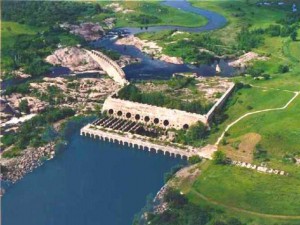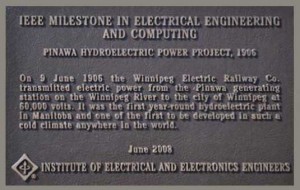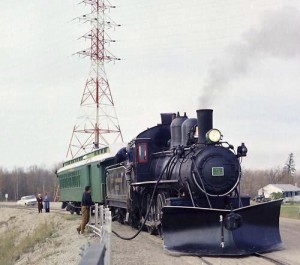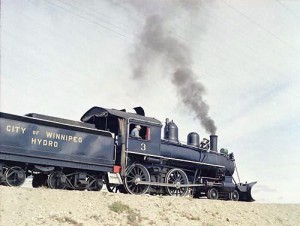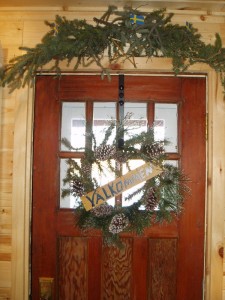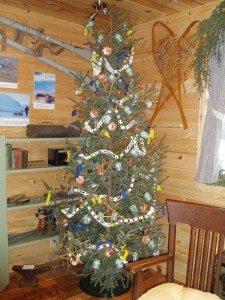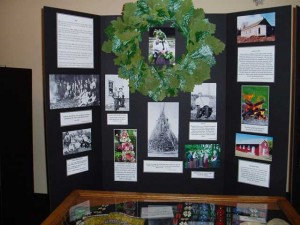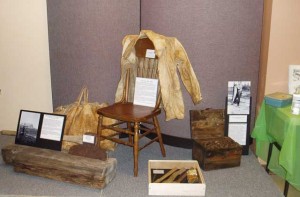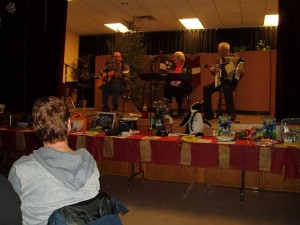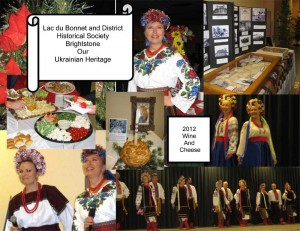A comprehensive History of the Pinawa Dam as a generating station can be obtained at these locations:
- Pinawa Dam History - Friends of Old Pinawa
- Pinawa 1906-1951 - Manitoba Electrical Museum, Inc.
Pinawa Dam Heritage Park
The park is located beside highway 520. The location of this park was originally a hydroelectric dam built between 1903-06 to provide electricity to the province of Manitoba and the city of Winnipeg. Strangely, it was not until after this facility closed that neighbouring communities received electrical power. It is one of many locations in the area like Slave Falls, McArthur Falls, Great Falls, Pointe du Bois and Pine Falls where the energy of the Winnipeg River is harnessed to develop electrical energy.
This generating station closed in 1951 and was partly demolished. The Canadian Army took it over and used the remaining Pinawa company town site houses and other buildings to stage battle scenes and effectively turned them into war-zone rubble. Then they left.
In 1986 the Manitoba Government, Department of Natural Resources re-named it Pinawa Dam Heritage Park, and it was open to the general public again. It is cared for by a dedicated non profit group of volunteers called The Friends of Old Pinawa.
The Pinawa Dam Heritage Park is commonly referred to as Old Pinawa Dam. Ever since the hydro operations ceased it has been a favorite gathering place for area teenagers during daytime and night-time. A sign stating that swimming can be dangerous has never stopped some daring people from enjoying its warm rapids. By late summer the water tumbles down with less gusto allowing those with nimble feet to walk across over the slippery moss covered rocks. Others use the rapids as a waterslide.
The Friends of Old Pinawa have worked diligently through the years to make what remains of the dam site safe for hiking, and the grounds tidy for families and other groups of people to enjoy. The Trans Canada Trail and a hiking trail go through the park and follow the Pinawa Channel. Snowmobilers drive through in wintertime.
Compiled by:
Miriam Simoens, Secretary
The Lac du Bonnet and District Historical Society Inc. June 2010
The Town of Pinawa, Manitoba (built in 1963)
The only way to enter the town of Pinawa by vehicle is to drive to the end of Highway 211. Pinawa is situated beside the Winnipeg River and at the northern edge of the Whiteshell Provincial Park.
The name comes from a First Nations term for calm water. The town built by the Canadian Government for Atomic Energy (AECL) to provide housing and recreation for the the employees of its research station located several miles away. The station is presently being de-commissioned so the town gradually changing from a company town to include cottages and tourists.
Pinawa offers many summer recreation possibilities such as boating, canoeing, fishing, hiking, biking and swimming. The Trans Canada Trail goes through here. There are wonderful hiking trails like the Ironwood Trail, Alice Chambers Trail and the Pinawa Chanel Heritage Walk. It offers an excellent nine hole golf course. During winter there is cross-country skiing, snowmobiling, skating and curling. The Eastern Manitoba Concert Association (EMCA) offers a delightful season of touring stage performers.
The inhabitants of Pinawa are not only people because many white tail deer have decided to call it home as well. The Highway 211 is a good place for spotting the great grey owl, our Provincial Bird. Because the town is surrounded by Canadian Shield wilderness the area is great for spotting a wide variety of birds and animals.
Compiled by:
Miriam Simoens, Secretary
The Lac du Bonnet and District Historical Society Inc. June 2010
